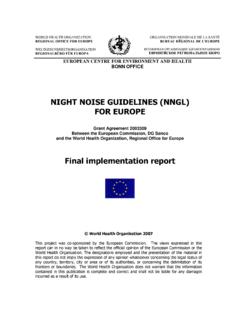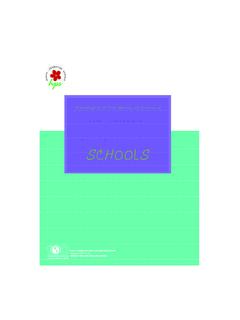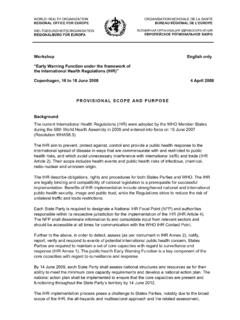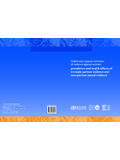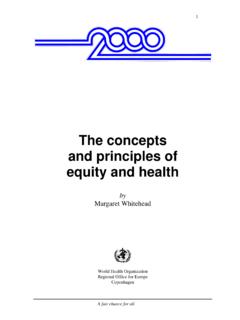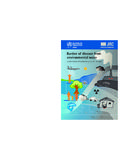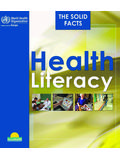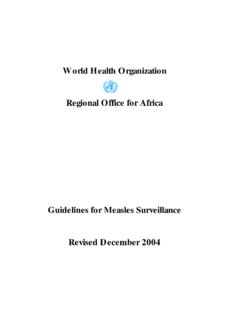Transcription of AUSTRALIA–WHO Country Cooperation Strategy 2018–2022
1 AUSTRALIA WHO Country Cooperation Strategy 2018 2022 AUSTRALIA WHO Country Cooperation Strategy 2018 2022 world health organization 2017 Some rights reserved. This work is available under the CC BY-NC-SA IGO licence. Photo credits: Cover: 2008 Charlie Tjapangati; image courtesy WHO, Papunya Tula Artists and Utopia Art SydneyInside pages: WHO/Yoshi Shimizu, except for p. 6: AFPABOUT THE COVER ARTWORKS toryThe Tingari are a group of ancestral beings of the Dreaming a mythological time believed in many Australian Aboriginal cultures to be the traditional era of work relates the stories of the Tingari Cycle, a series of ceremonies and rituals conducted over vast stretches of the Country , at sites of particular sacred or practical the specific details of these events are protected and passed down within traditional communities, the stories recount the sharing of knowledge among the Aboriginal peoples of Australia, particularly from elders to ancestral stories now form part of the teachings to Aboriginal youths following their initiation into their community, and provide context for contemporary values collaboration and sharing of knowledge among the countries and areas of the Western Pacific Region, in all the diversity of their geography, culture and customs.
2 The Government of Australia donated this art work to the WHO Western Pacific regional Office, to symbolise the rich and enduring tradition of dialogue, storytelling and information sharing among the Member States of the Western Pacific artistCharlie Tjapangati was born at the site of Tjulurrunya, to the west of Kiwirrkura in Western Australia. In the early 1960s, as a teenager, Charlie travelled to Papunya, a small Indigenous community in the Northern Territory, where he was , Charlie is a highly respected elder of the region who carries the knowledge of the Dreaming stories, particularly the Tingari Cycle. As is tradition, he is responsible for passing these sacred Dreamings on to young Aboriginal men during their initiation works are part of collections across Australia, including in the National Gallery of Australia, as well as the Aboriginal Art Museum of the Netherlands and the University of Virginia in the United ..viExecutive summary ..vii1. Introduction.
3 12. WHO: The global guardian of health ..43. health in Australia ..64. Australia s contribution to global health ..145. Australia WHO strategic agenda for Cooperation ..17 FOUNDATION 1. WHO contributes to the health of all Australians ..17 FOUNDATION 2. Australia, facilitated by WHO, contributes to addressing health priorities in the Region and globally ..18 FOUNDATION 3. Australia and WHO work in partnership to promote better health outcomes ..18 Strategic Priority 1 Enhancing health security ..19 Strategic Priority 2 Promoting people-centred health systems and universal health coverage (UHC) ..20 Strategic Priority 3 Strengthening health regulation ..21 Strategic Priority 4 Working together to support WHO in its efforts to achieve organizational excellence ..226. Implementing the agenda .. Core health indicators ..27vFOREWORDThe Australian Government Department of health , in collaboration with government agencies responsible for the health portfolio, and the world health organization (WHO) regional Office for the Western Pacific are pleased to present this Australia WHO Country Cooperation Strategy 2018 2022, the first such Strategy between Australia and WHO.
4 This is the first Country Cooperation Strategy (CCS) to focus on a high-income Country in the Western Pacific Region. Better leveraging Australia s vast experience and technical expertise in health can help deliver on WHO s mandate and mission in the Region. At the same time, working closely together on issues of mutual importance will help advance Australia s domestic and regional health interests. Building on an already exceptionally strong relationship, and in the context of the 2030 Sustainable Development Agenda, this Strategy provides a platform at the regional level to further strengthen and guide collaborative efforts to improve health in the Western Pacific Region and beyond in the next five years. This collaboration is underpinned by three key foundations of Cooperation : first, WHO contributes to the health of all Australians; second, Australia, facilitated by WHO, contributes to addressing health priorities in the Region and globally, and; third, Australia and WHO work in partnership to promote better health .
5 This CCS identifies four strategic priorities as a focus for the partnership over the coming five years: 1) health security; 2) people-centred health systems for universal health coverage (UHC); 3) regulatory strengthening; and 4) working together to support to WHO in its efforts to achieve organizational by this Strategy , the Department of health and the WHO regional Office for the Western Pacific remain committed to improving the health of Australians and the nearly billion people of the Western Pacific Region and Hon Greg Hunt, MPDr Shin Young-sooFederal Australian Minister for HealthFederal Australian Minister for SportRegional Director for the Western PacificWorld health OrganizationAUSTRALIA WHO Country Cooperation Strategy 2018 2022viABBREVIATIONSAHPRA Australian health Practitioner Regulation Agency AMR antimicrobial resistance CCS Country Cooperation strategyDFAT Australia Government Department of Foreign Affairs and TradeIHR (2005) International health Regulations (2005)
6 MRFF Medical Research Future FundNCD noncommunicable diseaseNHMRC National health and Medical Research CouncilSDG Sustainable Development GoalTGA Therapeutic Goods AdministrationUHC universal health coverageWHO world health OrganizationWHO FCTC WHO Framework Convention on Tobacco ControlAUSTRALIA WHO Country Cooperation Strategy 2018 2022 AUSTRALIA WHO Country Cooperation Strategy 2018 2022viiEXECUTIVE SUMMARYThis Australia WHO Country Cooperation Strategy 2018 2022 sets out a joint vision for the collaborative work of the Australian Government Department of health and the world health organization (WHO) from 2018 to 2022. Australia and WHO have a longstanding relationship, sharing expertise across a wide range of health issues. Australia s achievements in health include high life expectancy, a well-established universal health -care system, strong regulatory capacity, demonstrated resilience to health security threats and global leadership in many areas of public health , such as tobacco control.
7 However, Australia shares many common challenges with countries in the Western Pacific Region, including a rising burden of noncommunicable diseases, an ageing population and increasing demands on the health and WHO have worked together closely for nearly 70 years. Australia is an active WHO Member State contributing to regional and global health through its leadership on a range of priority health issues, collaborating with partners and exchanging expertise to promote best practices and supporting WHO to be a strong and effective organization . Australia is currently home to 46 WHO collaborating centres that work directly with the organization on a range of technical priorities. Building on this long-standing relationship, this, the first Country Cooperation Strategy (CCS) between Australia and WHO, is underpinned by three key foundations of Cooperation : first, WHO contributes to the health of all Australians; second, Australia, facilitated by WHO, contributes to addressing health priorities in the Region and globally; and third, Australia and WHO work in partnership to promote better the backdrop of the 2030 Sustainable Development Agenda, four strategic priorities have been identified to guide the technical areas that will be a focus for ongoing Cooperation between Australia and the WHO regional Office for the Western Pacific: STRATEGIC PRIORITY 1 Enhancing health security, with a focus on strengthening resilience to threats such as priority infectious diseases, emerging disease outbreaks and other emergencies with health consequences.
8 ViiiAUSTRALIA WHO Country Cooperation Strategy 2018 2022 STRATEGIC PRIORITY 2 Promoting people-centred health systems and universal health coverage (UHC), with a focus on exchanging information and expertise in health systems policy. STRATEGIC PRIORITY 3 Strengthening health regulation, to benefit from Australia s expertise in this area. STRATEGIC PRIORITY 4 Working together to support WHO in its efforts to achieve organizational excellence, building on the leadership of the regional Office for the Western Pacific in making WHO a more transparent, efficient, fit-for-purpose organization . Implementation of the CCS will be supported by six guiding principles: 1. Technical contribution2. Agenda shaping3. Information exchange4. Multisectoral approach5. Prioritization of vulnerable groups6. Open communication1 IntroductionA Country Cooperation Strategy (CCS) represents the world health organization (WHO) medium-term strategic vision for Cooperation with a Country . WHO has Cooperation strategies in place with low- and middle-income countries where a WHO Country office is located or where WHO is providing direct support to a Member State.
9 In an effort to strengthen Cooperation with all WHO Members States and to better leverage the expertise and experience of high-income countries, WHO is also seeking to develop CCSs with ministries of health in high-income countries in the Western Pacific Region. Through this new approach to the development of CCSs, the WHO regional Office for the Western Pacific will strategically engage with those Member States that can draw on their national expertise and experience to make significant regional and global contributions to health . This Australia WHO Country Cooperation Strategy 2018 2022 provides a valuable platform for strategic collaboration and builds on the technical expertise agencies responsible for Australia s health portfolio have on priority health issues. AimThe aim of this CCS is to strengthen and guide Cooperation between agencies responsible for Australia s health portfolio and WHO in areas of mutually agreed priority in an effort to improve the health of all populations in the Western Pacific Region and beyond.
10 Foundations of the CSSThis agreement is underpinned by three key foundations that form the basis of Cooperation between agencies responsible for Australia s health portfolio and WHO Country Cooperation Strategy 2018 2022 FOUNDATION 1 WHO contributes to the health of all AustraliansAustralia looks to WHO as the pre-eminent leader in global health . International norms and standards set by WHO influence the Australian Government Department of health s development and delivery of domestic health policy. FOUNDATION 2 Australia, facilitated by WHO, contributes to addressing health priorities in the Region and globally Australia is well placed to share its experiences and expertise with other countries, and also learns from other countries in addressing shared health challenges. WHO facilitates sharing of expertise and experience between Australia and other countries. FOUNDATION 3 Australia and WHO work in partnership to promote better health outcomesAustralia and WHO collaborate closely to promote stronger partnerships in support of improving health in the Region and globally.


